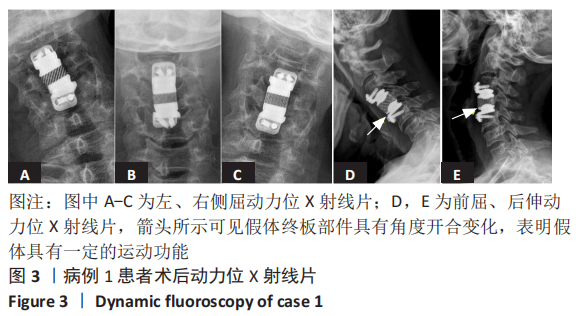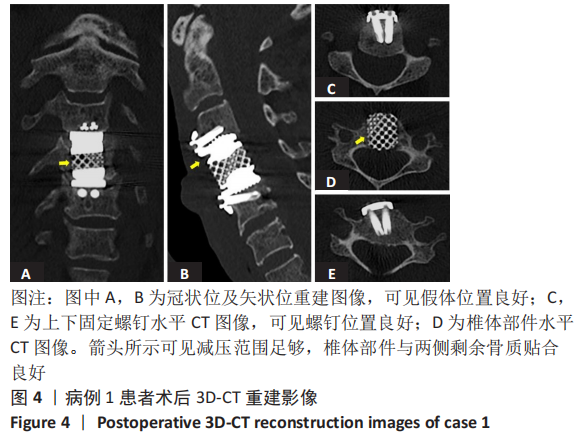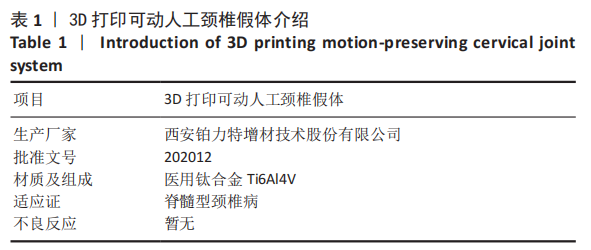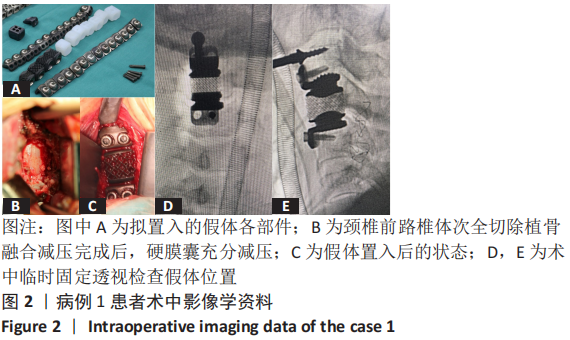中国组织工程研究 ›› 2021, Vol. 25 ›› Issue (36): 5810-5813.doi: 10.12307/2021.347
• 人工假体 artificial prosthesis • 上一篇 下一篇
3D打印可动人工颈椎假体置入治疗脊髓型颈椎病:国际首例报道
蔡 璇1,秦 杰1,贺西京1,2,董 军1,张 廷1,杨文龙1,王雄勋2,王自力2,王 栋1,李浩鹏1,贺高乐1,卢 腾1,李凌江2
- 1西安交通大学第二附属医院骨科,陕西省西安市 710004;2西安国际医学中心医院骨科医院,陕西省西安市 710100
Three-dimensional printing motion-preserving cervical joint system implantation for treatment of cervical myelopathy: the first case report
Cai Xuan1, Qin Jie1, He Xijing1, 2, Dong Jun1, Zhang Ting1, Yang Wenlong1, Wang Xiongxun2, Wang Zili2, Wang Dong1, Li Haopeng1, He Gaole1, Lu Teng1, Li Lingjiang2
- 1Department of Orthopedic Surgery, Second Affiliated Hospital of Xi’an Jiaotong University, Xi’an 710004, Shaanxi Province, China; 2Orthopedic Hospital, Xi’an International Medical Center Hospital, Xi’an 710100, Shaanxi Province, China
摘要:
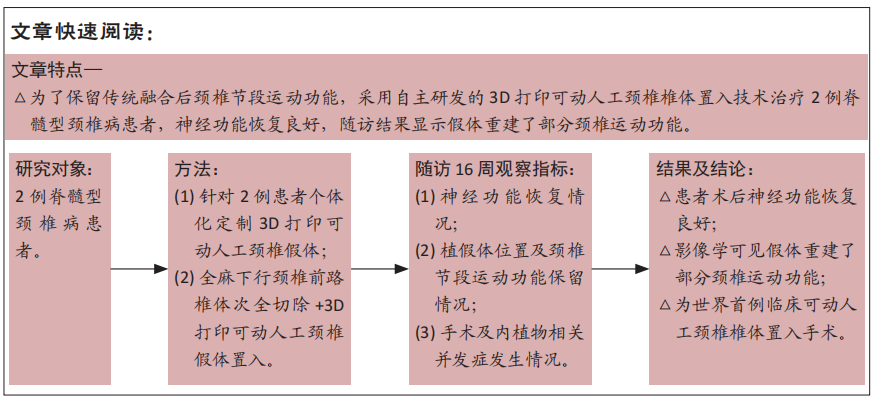
文题释义:
可动人工颈椎:颈椎椎体肿瘤、退变、严重椎间盘脱出等导致的颈椎疾病常需要行椎体次全切手术,为了重建手术节段颈椎的稳定性,需要进行融合固定,导致节阶段颈椎运动功能丧失。为了保留手术节段颈椎的运动功能,颈椎可动固定技术应运而生。可动人工颈椎为可动固定技术中的一种,是非融合固定技术,设计上为类关节结构,在椎体之间进行固定,功能上部分或者完全替代原椎体及椎间盘功能。颈段脊髓压迫症:是指各种不同原因的颈椎病变导致脊髓受压或脊髓缺血,继而引起脊髓功能障碍的临床综合征。其病因主要有颈段的巨大椎间盘突出、椎体肿瘤、椎体后缘骨刺、钩椎关节增生,后纵韧带骨化等,可引起四肢功能障碍、尿便控制困难等严重后果。
背景:目前,颈椎椎体切除减压后必须施行融合手术重建颈椎的稳定性,但融合牺牲了手术节段颈椎的活动功能,同时众多文献报道融合术后存在潜在的局部应力转移、邻近节段退变等远期问题。作者在颈椎前路椎体、椎间盘次全切后保留颈椎运动单元活动功能方面做了一些研究与探索,结合3D打印技术研制出了“人工颈椎椎体-椎间盘复合体”,简称可动人工颈椎。
目的:探讨3D打印可动人工颈椎椎体置入治疗2例颈段脊髓压迫症患者的近期临床疗效与术后颈椎活动度保留情况。
方法:为了保留椎体次全切除术后颈椎节段运动功能,2020年12月采用自主研发的3D打印可动人工颈椎椎体置入到2例因巨大椎间盘脱出行椎体次全切除的颈椎椎间缺损区。截止投稿时2021年4月共随访16周,分别于术后1,6,12,16周时采用目测类比评分及JOA评分对患者疼痛程度及神经功能恢复情况进行评估;采用动力位X射线片及三维CT等影像学技术评价植假体位置及颈椎节段运动功能保留情况,同时观察并记录患者随访期间手术相关并发症发生情况。研究经西安国际医学中心医院伦理委员会批准,伦理批件号:202012。
结果与结论:①2例患者术后次日疼痛、麻木均明显减轻,四肢肌力部分恢复。②术后1,6,12,16周随访时,患者四肢肌力、目测类比评分、JOA评分均较术前明显改善,头颈部活动功能良好。随访期间未发生切口内血肿、喉返神经损伤、食管损伤、脑脊液漏、切口感染、螺钉松动等情况。③术后1,6,12,16周随访时,X射线片检查可见患者颈椎生理曲度恢复良好,椎间高度维持良好;3D-CT显示减压效果良好,人工椎体部件与周边颈椎骨质贴合良好;动力位X射线片可见假体终板部件在屈伸及侧屈活动时具有一定的角度开合变化,无颈椎失稳,提示假体保留了部分颈椎运动功能。④结果提示,可动人工颈椎椎体能够在重建颈椎稳定性的基础上保留椎间活动功能。
https://orcid.org/0000-0002-5292-8340 (蔡璇)
中国组织工程研究杂志出版内容重点:人工关节;骨植入物;脊柱;骨折;内固定;数字化骨科;组织工程
中图分类号:
